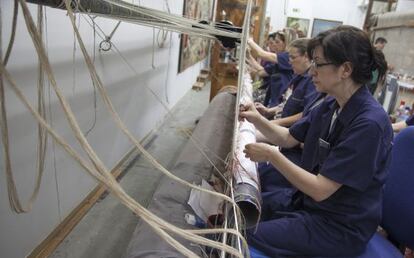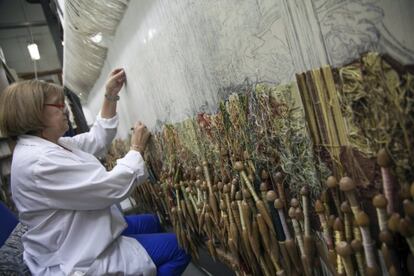Royal weavers still turning out tapestries despite no pay
Workers at the 300-year-old institution went on strike earlier this year to demand action

The staff at the Royal Tapestry Factory, an institution that is nearly 300 years old, have gone four months without pay.
Besides failing to send paychecks to its 52 workers, the non-profit foundation that runs the historical venture is also behind in its payments to Social Security, to providers and even to the electricity company, which is about to cut off their supply.
The foundation is a joint partnership by the City of Madrid, regional authorities, the Culture Ministry and the Caja Madrid Foundation.
It takes between four and seven months to create a square meter”
Curator Antonio Sama
This newspaper was unable to contact the director or any other official for comment.
Founded in 1721 by King Phillip V, Madrid’s Royal Tapestry Factory receives annual commissions from all over the world due to the exquisite work it turns out. These days, employees are working on a order of 28 pieces for the Royal Palace of Dresden, in Germany.
“We are unique to Europe. Yet we are not getting paid, and one of our employees could even be evicted from his home because he can no longer afford to pay the rent,” says Antonio Sama, a historian and curator at the factory.

The workers’ situation has gone from bad to worse since 2014, when they were not given their summer and Christmas pay, nor their bonuses.
“Last year we were not paid between June and August. In September, they promised to give us what we were owed gradually, over the rest of the year,” explains Rosario Cañete, one of the weavers.
Carmona: It's a shame
The leader of the Madrid Socialists, Antonio Miguel Carmona, visited the Royal Tapestry Factory on Wednesday to learn first-hand about the situation of its 52 employees.
Carmona wondered "how it is possible for three administrations [City Hall, regional government and Culture Ministry] to allow workers to go unpaid."
He described the situation as "a shame and evidence of a profound lack of culture."
But when Christmas came around, employers only handed over the summer pay, not the December one.
“We’ve accumulated four unpaid checks from this year and two from 2013,” adds José Luis Hijosa, a representative for the labor union UGT.
The workers finally decided to go on strike between May 19 and June 23 of this year. Once the protests ended, the foundation’s board agreed to “immediately resolve” the paycheck issue.
“They got together and agreed that each party would contribute the amount of money it owed. But to this day we haven’t seen a cent,” insists Hijosa, adding that in order to speed up proceedings, it was agreed to ask for a bank loan.
“The director, María Dolores Asensio, requested a loan for €300,000,” recalls the curator, Antonio Sama. “But this money has not arrived, and in any case it will not solve the situation, because in the meantime more unpaid wages, taxes and provider invoices have been piling up.”
The workers are not sure why the Royal Tapestry Factory is in such a bad financial situation.
We want two things. For payments to be honored, and a guarantee that the institution will continue to exist”
“All we know is, there are fewer subsidies these days,” says one worker.
“We want two things,” adds the unionist Hijosa. “For payments to be honored, and a guarantee that the institution will continue to exist.”
Many of the weavers at this factory, where the average age is 55, began working here when they were 14.
“We keep coming despite the extreme situation because we like our trade,” say the weavers Rosario Cañete and Veridiana Cabas almost simultaneously.
Hijosa is proposing for the older weavers to retire and make room for younger workers who could learn the trade and ensure the continuity of a factory that has been awarded a Special Designation of Cultural Interest.
“In any case, we can’t stop coming because we have a contract,” adds Sama. “We are keeping our side of the deal even though they are not keeping theirs.”
No official version
This newspaper was unable to obtain an official version of the story from either management at the Royal Tapestry Factory or from any of the institutions that sit on the board. The Culture Ministry merely said that it is seeking “a joint solution” with the other trustees.
Meanwhile, back in the workshop on Fuenterrabía street, weavers continued to go about their work on Wednesday. Using a machine that is a replica of a 18th-century model, Pilar Felguera sketched out the drawing for one of the 28 tapestries commissioned by Dresden Palace. Each one will measure 3.5m x 60cm.
“They want them done in silk and wool, with motifs which are reproductions of 17th-century originals. This one, for instance, also has gold threads,” she explained proudly.
“It takes between four and seven months to create a square meter,” explains Sama. It does not sound like so very long, considering that the weaver is drawing point by point on each one of the thousands of threads sitting in front of her.
English version by Susana Urra.
A 294-year history
Phillip V creates the Royal Tapestry Factory. The monarch wanted textile independence, so Spain would no longer have to depend on French or Flemish manufacturers. The factory opened in 1721.
The first director. Jacob Vandergoten began working with designs (known technically as cartoons) brought in from Flanders, but soon Spanish painters dear to the king joined the venture.
Goya painted 72 cartoons. The tapestries were hung at the royal residences of San Lorenzo de El Escorial and El Pardo between 1775 and 1793.
Global fame in the 19th and 20th centuries The factory received commissions from palaces and hotels from all over the world during this period.
In 1996, it becomes a foundation. The non-profit organization was created with the designated goal of "guaranteeing [the factory's] future."
Tu suscripción se está usando en otro dispositivo
¿Quieres añadir otro usuario a tu suscripción?
Si continúas leyendo en este dispositivo, no se podrá leer en el otro.
FlechaTu suscripción se está usando en otro dispositivo y solo puedes acceder a EL PAÍS desde un dispositivo a la vez.
Si quieres compartir tu cuenta, cambia tu suscripción a la modalidad Premium, así podrás añadir otro usuario. Cada uno accederá con su propia cuenta de email, lo que os permitirá personalizar vuestra experiencia en EL PAÍS.
¿Tienes una suscripción de empresa? Accede aquí para contratar más cuentas.
En el caso de no saber quién está usando tu cuenta, te recomendamos cambiar tu contraseña aquí.
Si decides continuar compartiendo tu cuenta, este mensaje se mostrará en tu dispositivo y en el de la otra persona que está usando tu cuenta de forma indefinida, afectando a tu experiencia de lectura. Puedes consultar aquí los términos y condiciones de la suscripción digital.
Últimas noticias
Reinhard Genzel, Nobel laureate in physics: ‘One-minute videos will never give you the truth’
Pinochet’s victims grapple with José Antonio Kast’s rise in Chile
How Japan is trying to avert ‘digital defeat’
The complicated life of Francesca Albanese: A rising figure in Italy but barred from every bank by Trump’s sanctions
Most viewed
- Pablo Escobar’s hippos: A serious environmental problem, 40 years on
- Why we lost the habit of sleeping in two segments and how that changed our sense of time
- Trump’s obsession with putting his name on everything is unprecedented in the United States
- Charles Dubouloz, mountaineering star, retires at 36 with a farewell tour inspired by Walter Bonatti
- The Florida Keys tourist paradise is besieged by immigration agents: ‘We’ve never seen anything like this’








































